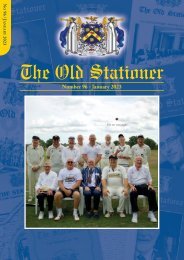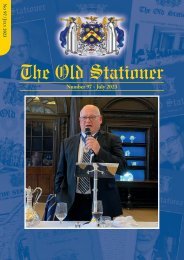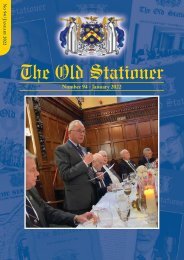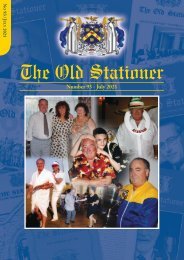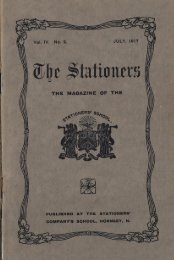OSAmag80
Create successful ePaper yourself
Turn your PDF publications into a flip-book with our unique Google optimized e-Paper software.
My first excursion to Norway was prompted by my sister,<br />
Bethan deciding she was going there to look for a new venture<br />
abroad. From living in the district of Jesmond, a more affluent<br />
area of Newcastle upon Tyne in those days and working in the<br />
Teaching Profession in the new town of Killingworth, it was<br />
an easy crossing embarking on the 'Leda' from Tyne<br />
Commissioners Quay. So I followed her route by boat to<br />
Bergen at Easter 1971 for my first visit in the snow and ice<br />
and had my first taste of this Scandinavian country. Three<br />
years later after an initial taste I returned again in the summer<br />
of 1974. This time, my sister and I had a plan to travel in an<br />
Austin 1300, to once again take the same crossing to Bergen<br />
across the North Sea, but this time to drive to the North<br />
Cape, the most northerly point in Norway, by travelling<br />
hopefully! Travelling the Fjord Coast by using numerous<br />
ferries and moving north to the Svartisen Glacier and passing<br />
the Arctic Circle at 66.5 degrees North we arrived at the<br />
North Cape after motoring for ten days and just under 2000<br />
miles, were all part of the experience.<br />
Forty years on, no longer is it possible to take the ferry from<br />
Newcastle on Tyne any more as it has not been available for a<br />
number of years. The chosen route was the Channel Tunnel<br />
and travel through France, Belgium, Netherlands and to<br />
Germany on the first day for a weekend sojourn in Eime, near<br />
Hanover. After the short stay, the route was now north to<br />
Hamburg and skirting Lubeck, a delightful city, before pulling<br />
up for the crossing to Denmark, from Puttgarden to<br />
Rodbyhavn. There was a twenty minute wait and a forty five<br />
minute crossing which made it a very efficient crossing from<br />
Fehmarn to the island of Lolland in Denmark, probably the<br />
most efficient and shortest link from Germany to Denmark's<br />
capital, Copenhagen. However, the journey continued to the<br />
next island, Falster and then across another stretch of water by<br />
bridge to Vordingborg on Sjaelland (Zealand) the main island<br />
of Denmark. Skirting Naestved, the overnight stop was at the<br />
hotel Sorup Herregard, near the hamlet of Vetterslev just off<br />
the main road to Ringsted. The journey was 324 miles.<br />
The next day of the journey included a short visit to Ringsted<br />
and then to Roskilde before a walk through the baroque<br />
gardens and fountains of the Castle (slot) of Fredericksborg<br />
before making for the ferry from Helsingor (Elsinore) in<br />
Denmark and arriving in Halsingborg in Sweden. Again the<br />
ferry crossing with Scandlines was very efficient and one is<br />
also rewarded with a clear view of Hamlet's Cronburg Castle.<br />
Our main route was now the E6 North. One detour was made<br />
T h e O l d S t a t i o n e r - N o 8 0<br />
NORWAY REVISITED 40 YEARS ON<br />
to the coast to see the town of Halmstad. The E6 eventually<br />
brings one to Goteborg (Gothenburg), the second city of<br />
Sweden, a journey of 242 miles if you ever consider doing the<br />
drive from Central Sjaelland (Zealand). The accommodation<br />
in Goteborg was the Ibis Hotel on a boat on the quayside<br />
which is not far from the City Centre.<br />
Departure next day was 9.00am with a short drive around<br />
town before continuing north on the E6, with a deviation<br />
planned on the E45, following the Gota River upstream to<br />
visit Trollhattan and the Gota Canal, where there are locks<br />
taking the boats up and downstream. Returning by the E44<br />
westwards to the E6, once more the journey continued north<br />
towards Oslo. Staying in the west of town, it was more<br />
convenient to take the tunnels under the Oslo Fjord to reach<br />
the Scandic Hotel on the site of the former airport at Fornebu.<br />
A meal in the centre near Akersgata not far from the Radhaus<br />
(Town Hall) on a balmy evening was a change from the<br />
driving of the last three days. The evening allowed one time<br />
to drive up to Holmenkollen, the site of the Ski Jumping and<br />
the point of celebration of the National Day in Norway. The<br />
views looking over the City and the Oslo Fjord at dusk were<br />
very rewarding as the sun was setting.<br />
Holmenkollen ski slope<br />
We had the best part of two days to take in some of the sights<br />
of the Norwegian capital not seen since my last visit in 1974.<br />
The area of Bygdoy on the edge of the Oslo Fjord is not far<br />
from the centre and is where there are museums of boats.<br />
Thor Heyerdal's Kontiki is housed here with a vast amount of<br />
information and displays of his achievements in his balsa<br />
wood boat and Ra1 and 2. There is a second museum here of<br />
Viking Ships of Oseberg, Gokstad and Tune and the detail<br />
about these boats. The third of the three museums is the story<br />
of the Fram and the achievement of Amundsen being the first<br />
explorer to reach the South Pole who started his explorations<br />
in Northern Canada, then eventually wanting to go the<br />
Antarctic. There is also much on Scott of the Antarctic here<br />
and his very disappointing and sad attempt to be the first to<br />
reach the South Pole, but beaten by Amundsen.<br />
Another interesting visit is to Frogner Park where there is a<br />
vast array of Gustav Vigeland's work, mainly sculptures and<br />
statues. Vigeland lived from 1869-1943 and from the main<br />
gate take a walk up the wide path between the statues and<br />
end up at the centre piece on the lower terrace. Then climb up<br />
the steps to the twenty metre high obelisk, the Monolith<br />
between the 200 figures in bronze, granite and cast iron,<br />
depicting every emotion of humanity with the 'The Angry<br />
Child' being a popular photograph! Gustav Vigeland started<br />
his work as a wood carver but fell under the spell of Rodin and<br />
switched to stone, iron and bronze, starting work in the Park<br />
in 1924. and continuing till his death.<br />
During this visit there was an opportunity to go into the<br />
centre of Oslo, entering in front of the Palace and parking in<br />
39



